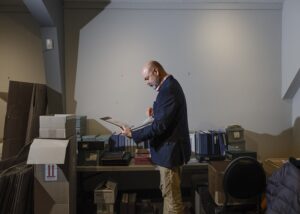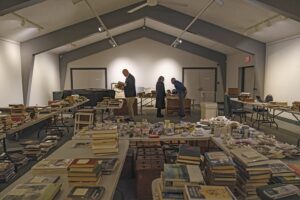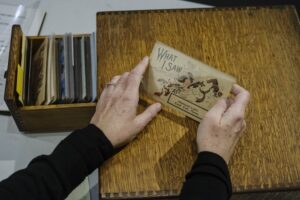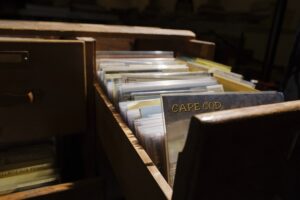For weeks, Samuel Tager and a small team have been unwrapping, sorting, and cataloguing a vast collection of Provincetown memorabilia donated to the Pilgrim Monument and Provincetown Museum by Sal Vasques, a native son who moved to San Diego in 1965.

The Vasques collection consists of thousands of items, ranging from autographed Norman Mailer novels to commemorative plates and spoons and 20,000 historic postcards.
When this trove was donated last fall, the museum was in transition. Courtney Hurst was serving as the interim executive director, and the institution had recently reversed a yearslong moratorium on acquiring additional historical materials. Hurst, who had been a board member for a dozen years, has since been hired as the executive director. The museum also hired Tager as full-time curator — a position that has been vacant for more than a decade.
“We were investing our resources in other places,” says Hurst. “Now it’s time to pour our assets and revenue into the museum collection and the team that runs it.”

Tager has set up a carpentry and welding shop on the grounds of the museum where he can build artifact supports and exhibition cases. He plans to make over the museum’s permanent displays and is developing ideas for special exhibitions, including one about the Cape School of Art, the institutional descendant of the art school founded by Charles Hawthorne. But for now, the Vasques collection is demanding most of his time.
Tager is tasked with uncovering the stories behind the stuff and turning the boxes of collectibles into a coherent narrative that reveals something special about the town’s history and one man’s effort to preserve it. The exhibition will open soon after the museum welcomes back visitors in April. It will be the first of two new exhibitions planned for 2025.
Tager began considering how to display the collection with a conceptual diagram composed of lines that define the exhibition space. He must make selections — for example, choosing which historic postcards to show visitors, how they will be displayed in cases, and how many to blow up and mount on the walls. He wants visitors to be able to grasp the full scale and volume of what Vasques has gathered over the years.

“The emphasis needs to be placed on Sal the collector,” says Tager. His is believed to be the largest private collection of Provincetown memorabilia in existence.
“We’d like to create an introduction to the exhibition about Sal’s family and why he got into collecting,” Tager says. Vasques worked in the tuna industry in San Diego, so Tager wants to show how that experience may have shaped the collection’s Provincetown fishing-related items.
A long-term project is to scan the 20,000 postcards into a searchable database, a process that involves matching binders full of information about the cards with the cards themselves, which are stored in separate boxes. The tedious process will nonetheless produce a treasure trove of historical insights that could be used, Tager says, in ways we can’t yet foresee.

In addition to the upcoming Vasques exhibition, Tager is also working on refreshing the museum’s permanent displays. “We really need to go through case by case,” Tager says. “There are a lot of cases that have very little interpretation, and some are dated. We have to give the public a clearer idea of both the past and present of the town.”
He’s currently working on the three display cases of artifacts brought to Provincetown from the Arctic by Rear Admiral Donald MacMillan. “We need to tell the who, what, where, why, when,” says Tager. Why, for instance, is a stuffed polar bear on display? To tackle this task, he’s writing text and including more objects and photographs. He’s also collaborating with Aden Choate, a reporter at the Provincetown Independent, to incorporate information from her research on Miriam MacMillian into the display. Miriam accompanied her husband on nine of his voyages and documented the lives and customs of Inuit people.
The museum’s war display cases will also get a reboot, with less emphasis on the Civil War era and a new story about the family and World War I service of Lewis A. Young, for whom the Provincetown VFW is named.
Tager’s interest in Provincetown’s stories comes from his lifelong connection to the place. “There’s nothing I’m quite as interested in,” says Tager. His parents met in Provincetown in the summer of 1949, and in 1967 they bought a house in the East End, where the family spent its summers.
Tager spent nearly three decades working at Harvard University’s museums, including a lengthy stint as director of exhibitions at the Peabody Museum of Archaeology and Ethnology. More recently, he became executive director of the Provincetown Public Art Foundation, a position he still holds. He views curatorial work as collaborative and open-ended, and he’s never sure what discoveries a collection of artifacts might reveal. He tries to avoid making assumptions about where a story might lead. As an example, he describes a project he worked on with a Harvard collection of glass plate negatives of a meso-American archaeological site in Copan, Honduras.

“We started scanning the negatives of photographs taken from the 1890s through the 1930s, and we thought they were going to tell us a lot about final phase archaeology and what these sites looked like when they were first discovered and excavated,” he recalls. “But we ended up telling a story about the Hondurans working at the site, and we organized a project where we reconfigured the identities of these formerly anonymous people. It turned out many of them were the ancestors of the current residents of Copan.”
When Harvard brought the exhibition to a community center, Tager says, “People walked overnight with their children to come to the opening.” The experience provided a powerful illustration of people’s yearning to find themselves in local history.
Hurst, who grew up in Provincetown, hopes that the museum becomes a place where residents can discover their own history, and visitors can learn about Provincetown’s outsize contributions to American history. She remembers waitressing as a teenager at the Surf Club and advising tourists to climb High Pole Hill for the view.
“It’s just become very clear to me, now that I’m sitting in this seat, that I want to change that narrative,” she says. “So, when people ask, ‘Why go up there?’ the answer is, ‘They have an amazing museum. They tell the coolest stories about Provincetown and its people and, oh, the view is nice, too.’ ”



